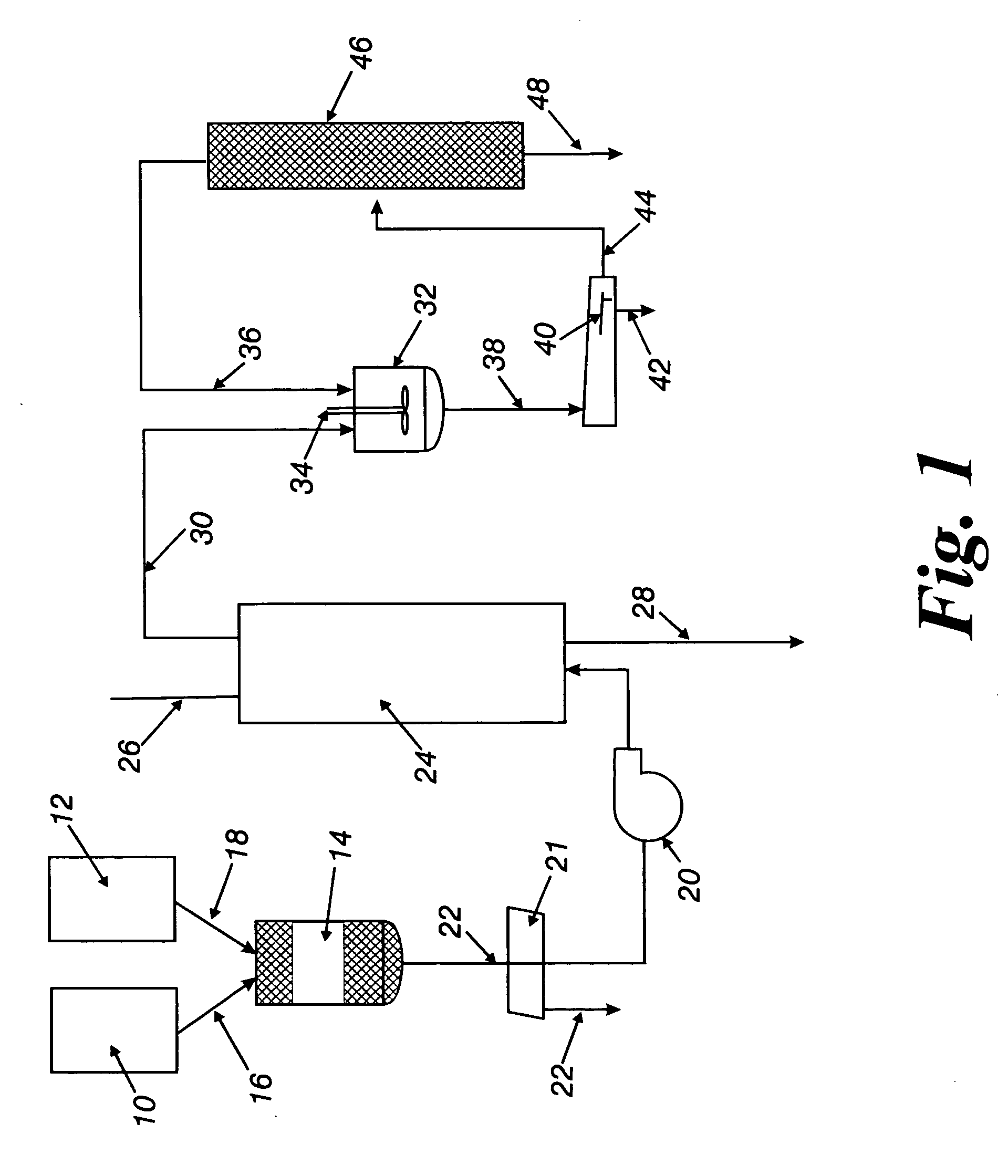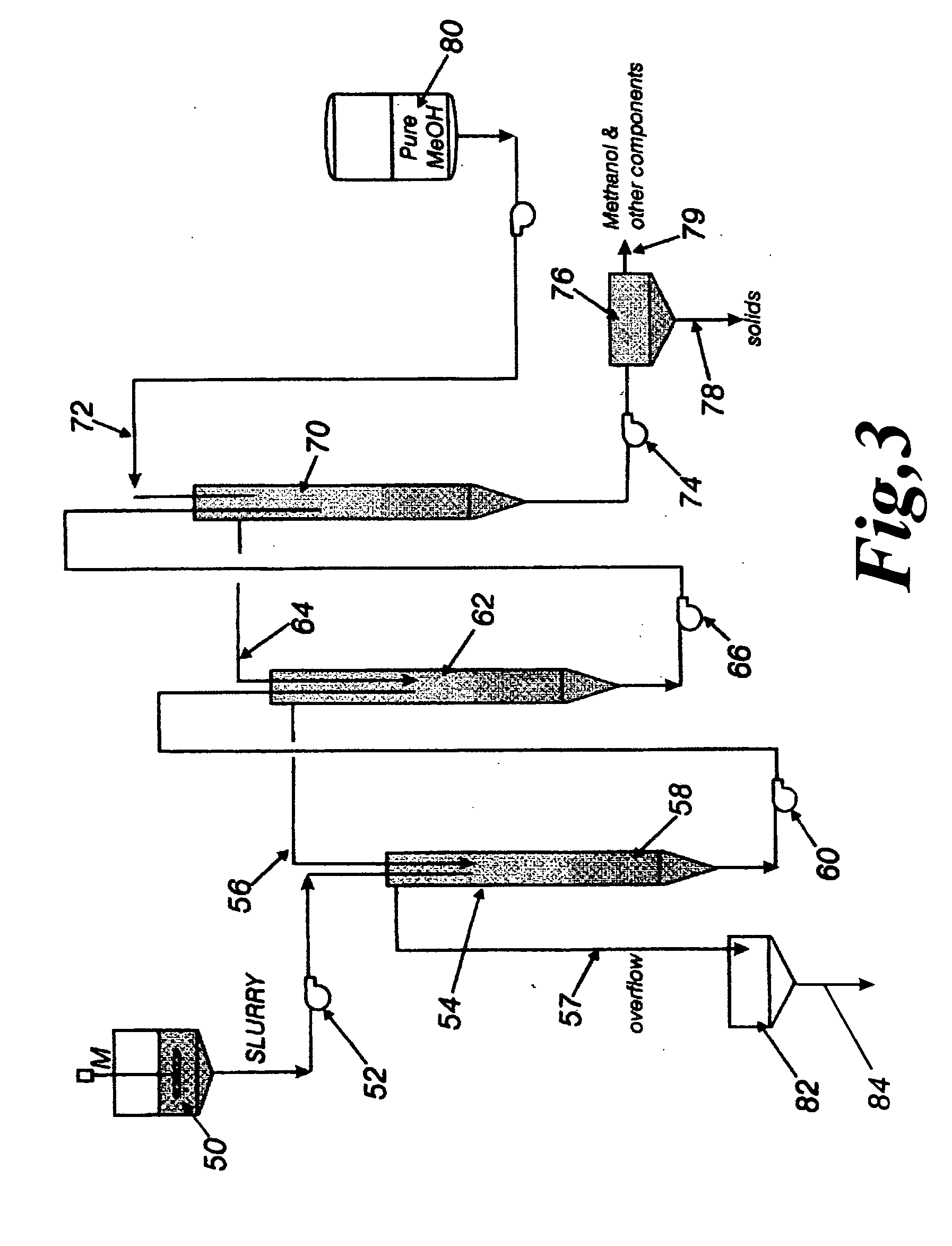Process for recycling polyester materials
a polyester material and polyester technology, applied in the field of polyester material recycling, can solve the problems of inability to purify, inability to meet the requirements of recycling, and high cost of removal of certain contaminants generally present in waste pet,
- Summary
- Abstract
- Description
- Claims
- Application Information
AI Technical Summary
Benefits of technology
Problems solved by technology
Method used
Image
Examples
example 1
[0043] Several batches of glycolysis product were prepared by glycolyzing (dissolving) green bottle flake according to the ratio of 10:7 wt PET:wt EG at a temperature greater than 200° C. The glycolysis product was then pumped through a carbon bed prepared by adding 1500 grams of coconut shell carbon pellets having a diameter between 2.4 and 5.0 mm, to a 316 stainless steel pipe 2″ internal diameter and 4′ long. The carbon bed was maintained at a temperature above 170° C. The green glycolyzed bottle flake was pumped through the column at a rate of about 20 ml per minute. The product was removed overhead of the column and had a yellow tint. All traces of blue colorant were absent. The glycolysis product was fed through the column continuously over the course of an eight-hour day, then shut down and drained. The next day the column was reheated and the glycolysis feed restarted. This procedure was repeated without the column being regenerated until the blue dyes were removed from a to...
example 2
[0045] A counter-current extraction method was also used to separate the BHET from the methanolic mother liquor of Example 1. The slurry from Example 1 is diluted with recycle methanol such that the slurry contains a weight ratio of 11:1 methanol:BHET. As illustrated in FIG. 3, this slurry 50 is pumped 52 into the first vessel 54, which is filled with methanol via line 56, and there the BHET 58 settles (as a concentrated suspension) to the bottom of the vessel. This concentrated suspension of solid BHET is then pumped 60 through the top of the second vessel 62 where it mixes with more methanol 64 and settles to the bottom of the second vessel in a yet more concentrated suspension. This new concentrated suspension of solid BHET is then pumped 66 into a third vessel 70 where it mixes with more methanol 72 and settles to the final concentrated suspension. This final concentrated suspension of solid BHET is pumped 74 into a solids receiver 76 where the final settled suspension of solid ...
example 3
[0047] This example is given to show that under PET glycolysis conditions, PVC, which is found as a contaminant with PET post consumer bottle flake, swells and can be filtered away from the glycolysis product.
[0048] Green PET bottle flake was glycolyzed according to Example 1, and excess EG was allowed to distill overhead of the glycolysis vessel until the temperature of the glycolysis mixture reached 240° C. A wire mesh basket containing a known amount of PVC was immersed into the glycolysis vessel. Periodically the basket was removed and the contents washed with hot acetone, then weighed. After weighing, the basket was returned to the hot glycolysis mixture.
[0049] As is shown in FIG. 2, the mass of the PVC in the basket (expressed as a percentage of the original mass added) increased due to swelling under glycolysis conditions. After approximately three to three and a half hours, the PVC had swelled to its maximum value and then began decreasing in weight as the rate of decompos...
PUM
| Property | Measurement | Unit |
|---|---|---|
| temperature | aaaaa | aaaaa |
| temperature | aaaaa | aaaaa |
| temperature | aaaaa | aaaaa |
Abstract
Description
Claims
Application Information
 Login to View More
Login to View More - R&D
- Intellectual Property
- Life Sciences
- Materials
- Tech Scout
- Unparalleled Data Quality
- Higher Quality Content
- 60% Fewer Hallucinations
Browse by: Latest US Patents, China's latest patents, Technical Efficacy Thesaurus, Application Domain, Technology Topic, Popular Technical Reports.
© 2025 PatSnap. All rights reserved.Legal|Privacy policy|Modern Slavery Act Transparency Statement|Sitemap|About US| Contact US: help@patsnap.com



